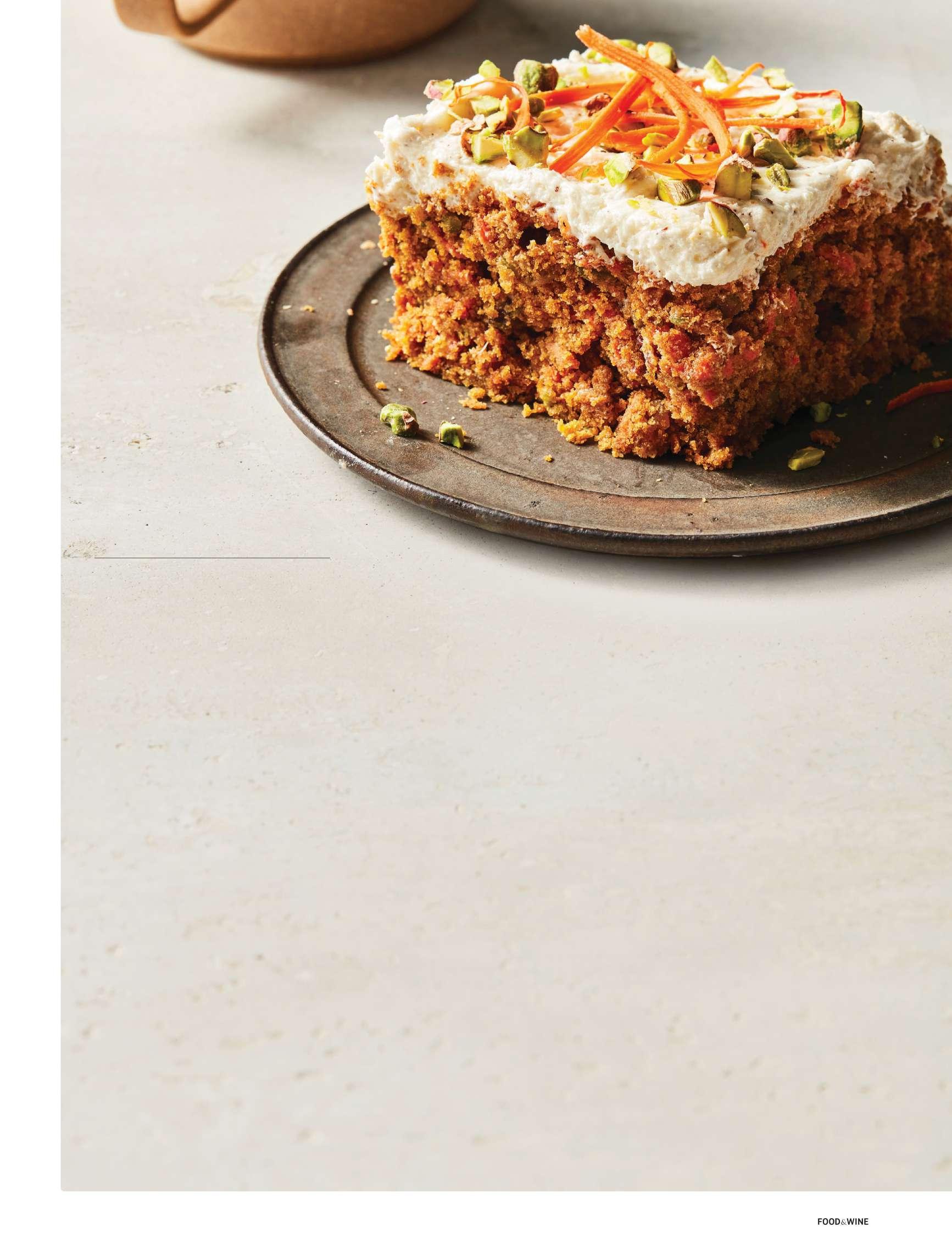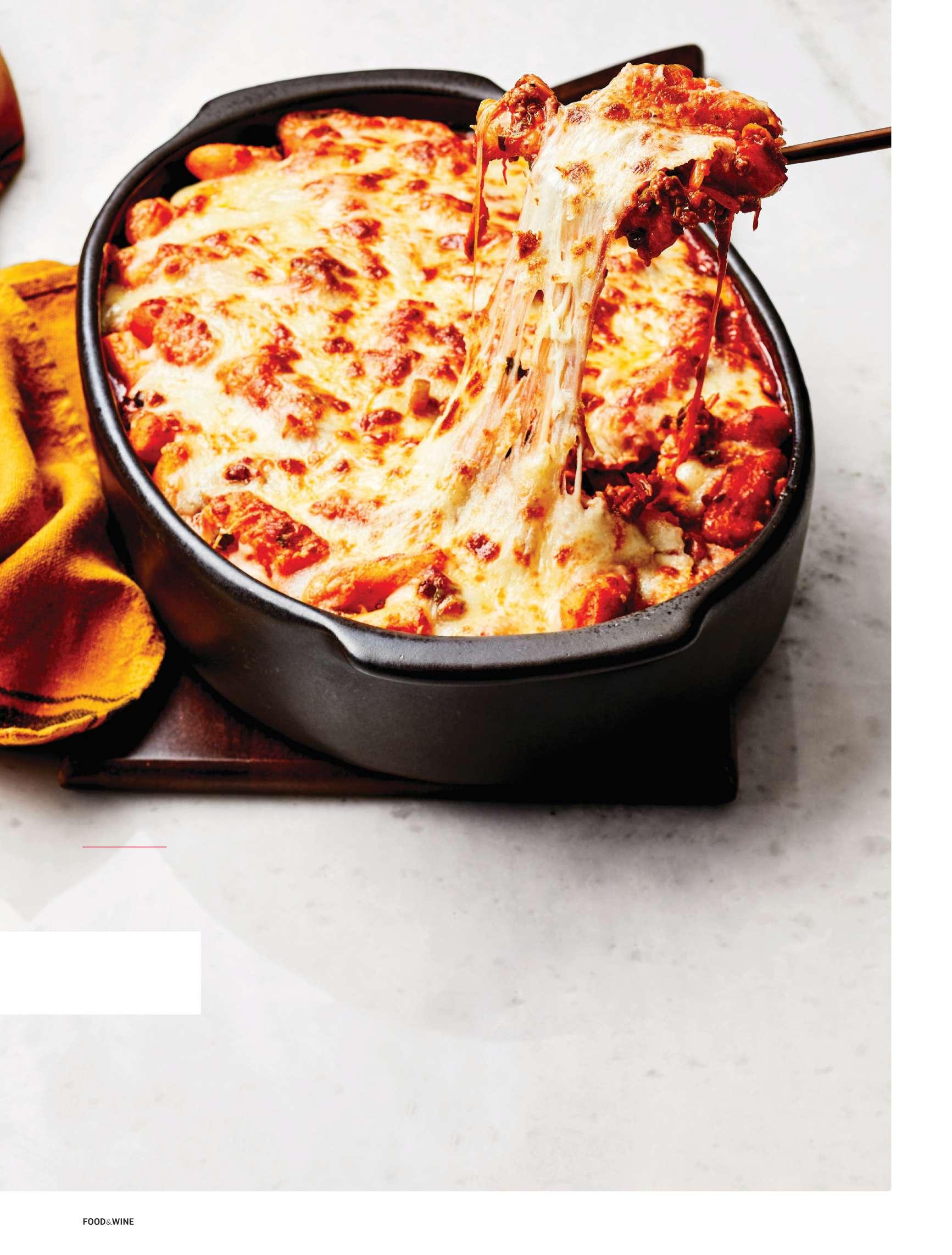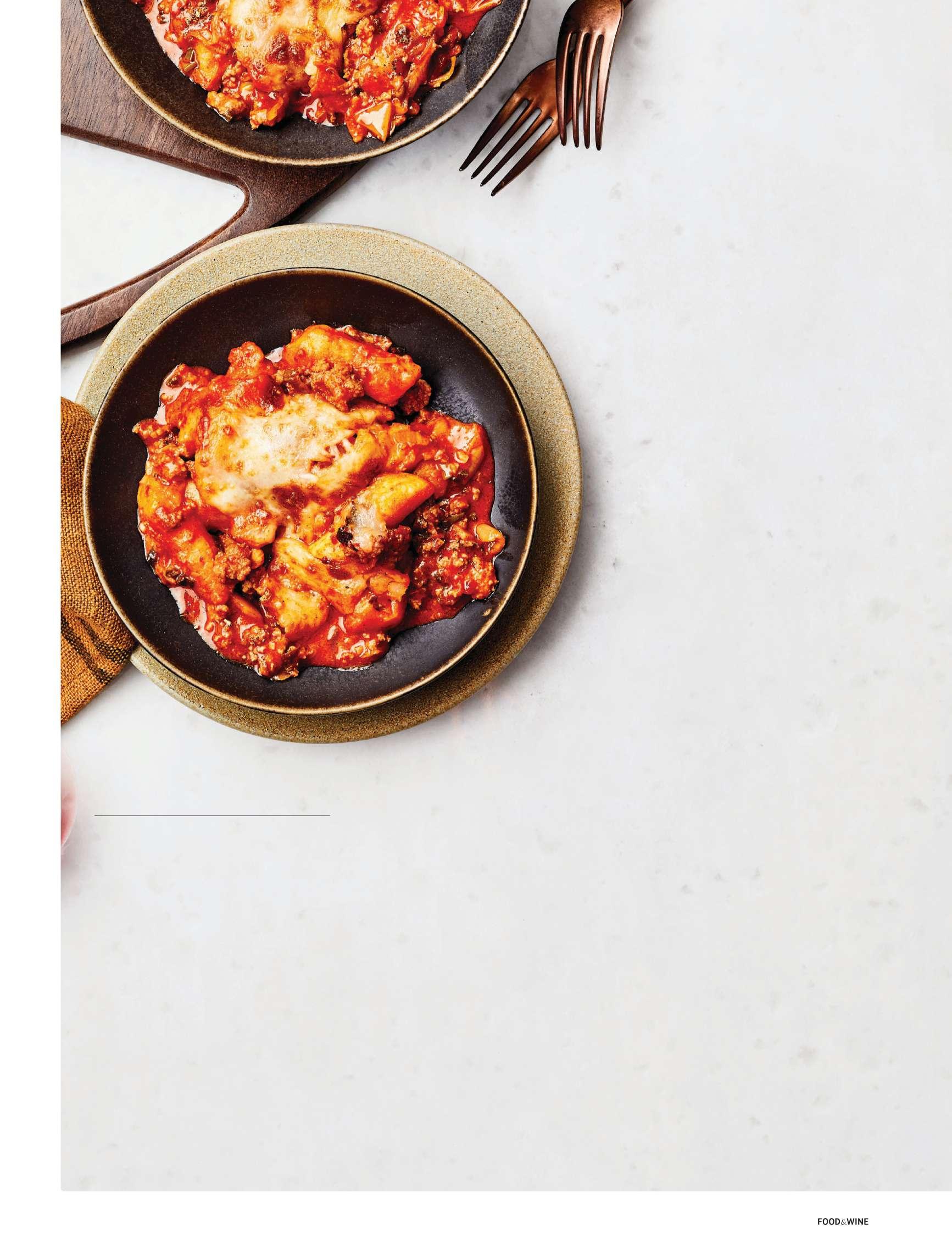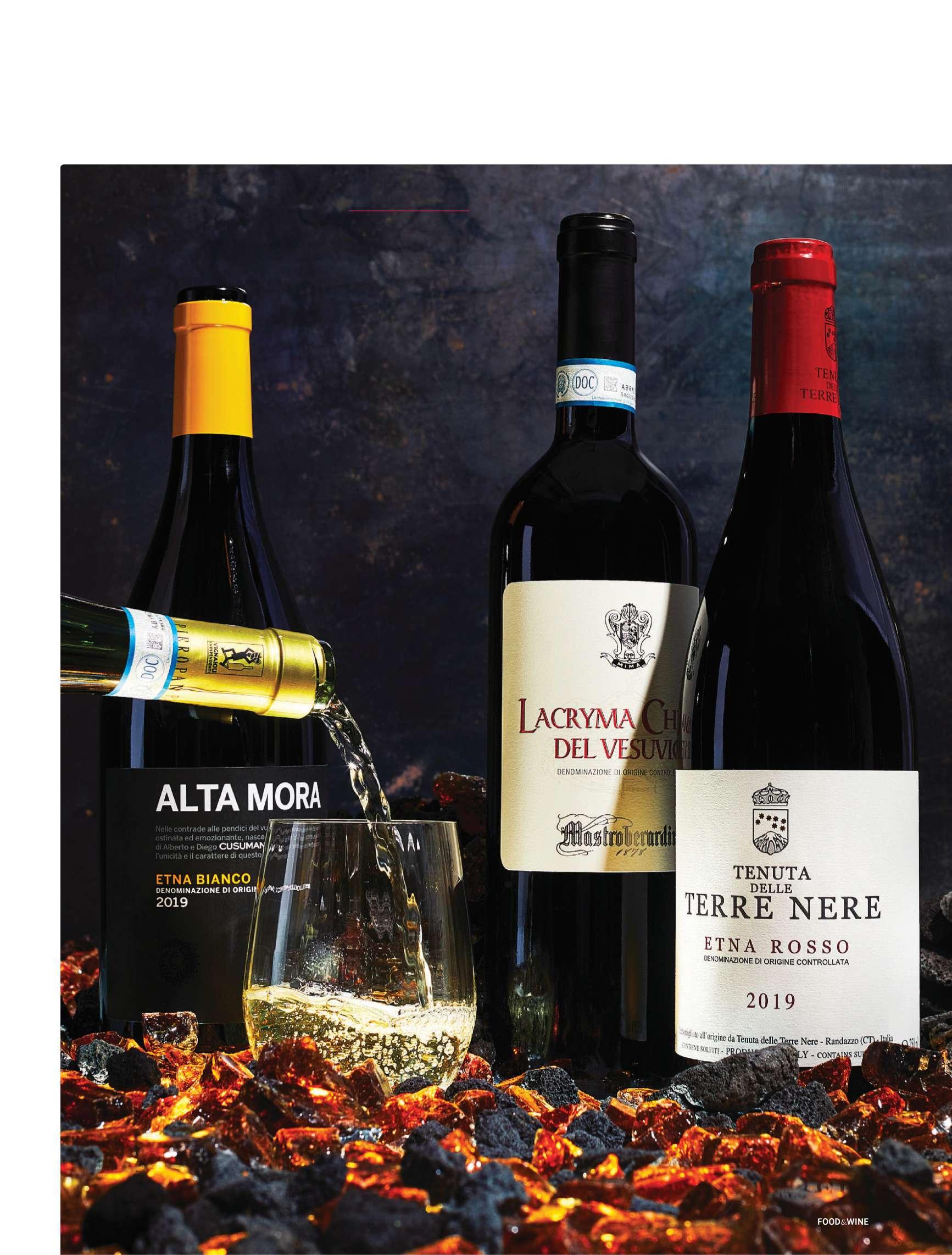
11 minute read
• Spiced Carrot Cake with Brown Butter Frosting

E A S Y B A K E S
Advertisement
Take Root Hetal Vasavada adds depth to carrot cake with cardamom, brown butter, and roasted pistachios.
Spiced Carrot Cake with Brown Butter Frosting
ACTIVE 30 MIN; TOTAL 3 HR SERVES 12
A warming blend of cardamom, ginger, cinnamon, and nutmeg spices up Hetal Vasavada’s tender, moist carrot cake studded with golden raisins and crunchy pistachios. Brown butter ghee does double duty in this recipe: It enriches and flavors the cake batter, while the caramelized milk fat left over from making it adds a nutty flavor to the traditional cream cheese frosting.

CAKE 1 cup plus 6 Tbsp. unsalted butter (11 oz.) Cooking spray 1 cup packed dark brown sugar 11/2 Tbsp. grated orange zest 4 large eggs 1 large egg yolk 1 Tbsp. vanilla extract 1 Tbsp. ground cinnamon 1 Tbsp. ground cardamom 2 tsp. ground ginger 1/2 tsp. ground nutmeg 41/2 cups shredded peeled carrots (from 1 lb. carrots) 11/4 cups unsalted roasted pistachios, coarsely chopped 1/2 cup golden raisins 22/3 cups all-purpose flour (about 113/8 oz.) 21/2 tsp. baking powder 1/2 tsp. baking soda 1/2 tsp. kosher salt
FROSTING
1 cup unsalted butter (8 oz.), at room temperature 4 oz. cream cheese, at room temperature 1 Tbsp. vanilla extract 21/2 cups powdered sugar (about 10 oz.)
ADDITIONAL INGREDIENTS
Finely chopped pistachios and shredded carrots, for garnish
1. Make the cake: Melt butter in a large, heavy-bottomed saucepan over mediumhigh, stirring often; gently simmer butter until white milk solids separate from butter- fat, about 10 minutes. Reduce heat to low, and cook, stirring constantly, until butter is golden brown and spoon is covered in flecks of caramelized milk solids, about 2 minutes. Remove from heat. Line a fine wire-mesh strainer with 3 layers of cheesecloth, and place strainer over a heatproof container. Pour melted butter through strainer and into container. Reserve caramelized milk fat (about 1 teaspoon), and set aside. Let strained ghee cool completely at room temperature, about 1 hour. 2. Preheat oven to 350°F. Coat a 13- x 9-inch baking pan with cooking spray; set aside. Combine brown sugar and orange zest in a large bowl. Rub orange zest into sugar using your fingers. Add eggs, egg yolk, vanilla, cinnamon, cardamom, ginger, nutmeg, and cooled brown butter ghee. Beat with an electric mixer on high speed until pale and fluffy, 2 to 3 minutes. Fold in shredded carrots, pistachios, and raisins until well combined. Whisk together flour, baking powder, baking soda, and salt in a medium bowl until combined. Fold flour mixture into carrot mixture, stirring until just combined. Pour batter into prepared pan; spread in an even layer. 3. Bake carrot cake in preheated oven until a wooden pick inserted in center comes out clean, about 35 minutes. Remove from oven. Let cool completely in pan, about 1 hour. 4. Meanwhile, make the frosting: Beat butter, cream cheese, vanilla, and reserved caramelized milk fat with a stand mixer fitted with the paddle attachment on medium-high speed until smooth, about 1 minute. Reduce mixer speed to low; gradually beat in powdered sugar until combined. Increase mixer speed to medium-high, and beat until pale and fluffy, 2 to 3 minutes. 5. Spread frosting onto cooled cake in an even layer. Garnish with finely chopped pistachios and shredded carrots, if
desired. —HETAL VASAVADA
MAKE AHEAD Frosting can be made up to 3 days ahead and stored in an airtight container in refrigerator; let come to room temperature before using.


M O S T W A N T E D
Easy, Cheesy At Kimika in New York City, Italian meets Japanese in this crispy, gooey lasagna.
RECIPE FROM
KIMIKA
CHRISTINE LAU, NEW YORK CITY BAKED UNTIL BUBBLING and golden brown, the lasagna at Kimika, a lively restaurant nestled between Little Italy and Chinatown in Manhattan, is full of surprises. It arrives at the table still piping hot from the oven with a jaw-dropping cheese pull. A layer of provolone cheese tempers the heat of what lies beneath: a deliciously piquant tomato sauce made with dashi, kimchi, ssamjang, and gochujang and into which ground pork, coriander, and garlic have been stirred. But the greatest aha! moment comes when your fork spears a tubular Korean rice cake, standing in here for lasagna noodles, bringing a chewy-tender bite to this decadent casserole. The Crispy Rice Cake Lasagna (recipe opposite) is the invention of chef Christine Lau, a Chinese American chef born in Oakland, California, and it leans into Kimika’s emphasis on Itameshi, the intersection of Italian and Japanese cuisines popular in Japan. A single large baking dish works well to serve a crowd at home, or you can divide the mixture into smaller gratin dishes before baking to make luxurious individual portions. —KELSEY YOUNGMAN
Crispy Rice Cake Lasagna

TOTAL 50 MIN; SERVES 6
Chewy, tender rice cakes are coated with a spicy sauce of sweet Italian sausage, gochujang, ssamjang, and kimchi. A caramelized, bubbly, stringy provolone topping helps temper the heat. Find tubular Korean rice cakes, which are sold partially cooked and vacuum-sealed, in the freezer section at Korean markets or on Amazon.
SWEET ITALIAN SAUSAGE
1 tsp. fennel seeds 1/4 tsp. coriander seeds 1 lb. ground pork 11/2 tsp. black pepper 11/2 tsp. granulated sugar 11/2 tsp. kosher salt 2 garlic cloves, minced (11/2 tsp.) 1/4 tsp. crushed red pepper 1/4 cup red wine
LASAGNA 1/2 cup vegetable oil, divided 13/4 cups gochujang 2 lb. Korean rice cakes (tubular shape) 2 cups dashi 1/4 cup tomato sauce 1 Tbsp. ssamjang 1 Tbsp. sesame oil 2 cups kimchi, drained (liquid reserved) and chopped 4 cups thinly sliced scallions (from 10 large scallions) 1/2 cup unsalted butter (4 oz.), cut into 1/2-inch pieces 1 oz. Parmesan cheese, grated (about 1/4 cup) 12 oz. provolone cheese, shredded (about 3 cups)
1. Make the sweet Italian sausage: Cook fennel seeds and coriander seeds in a small skillet over medium, stirring often, until seeds are toasted and aromatic, 2 to 3 minutes. Remove skillet from heat; let stand at room temperature until toasted seeds have cooled completely, 2 to 3 minutes. Grind toasted seeds in a spice grinder until finely ground, 30 to 45 seconds. Stir together ground seeds, ground pork, black pepper, sugar, salt, garlic, and crushed red pepper in a medium bowl until combined. Add wine, and stir until well combined.
2. Make the lasagna: Heat 1/4 cup vegetable oil in a shallow saucepan over medium-low. Add sweet Italian sausage; cook, stirring constantly using a whisk, until mostly cooked, 3 to 4 minutes. (Using a whisk is a chef’s trick to break up chunks of meat as it cooks. The sausage should not get any color or char.) Stir in gochujang; cook, stirring constantly using whisk, until sausage is completely cooked, 2 to 3 minutes. Transfer sausage mixture to a large heatproof bowl. Set aside until ready to use. 3. Heat remaining 1/4 cup vegetable oil in a large skillet over medium-high. Working in 2 batches if needed, add rice cakes to skillet; cook, flipping occasionally, until cakes are crispy on all sides, 6 to 8 minutes. Transfer rice cakes to a plate lined with paper towels, reserving oil in skillet. 4. Preheat oven to broil with rack about 6 inches from heat. Add dashi, tomato sauce, ssamjang, sesame oil, and reserved kimchi liquid to reserved vegetable oil in skillet. Bring mixture to a boil over medium-high. Boil, stirring occasionally, until mixture is reduced by half, about 5 minutes. Add crispy rice cakes and chopped kimchi to mixture, and gently stir to combine. Reduce heat to mediumlow; stir in scallions, butter, and Parmesan. Cook, stirring constantly, until sauce is emulsified, turns a creamy orange color, and coats rice cakes, 2 to 3 minutes. Remove from heat.
5. Transfer rice cake mixture to reserved pork mixture in bowl; gently stir until well combined. Transfer mixture to an ungreased 13- x 9-inch broiler-safe baking dish; sprinkle evenly with provolone. Broil in preheated oven until provolone is melted and golden brown, 4 to 5 minutes. Serve immediately. —CHRISTINE LAU,
KIMIKA, NEW YORK CITY
MAKE AHEAD Sweet Italian sausage can be made up to 3 days ahead and stored in an airtight container in refrigerator. WINE Fruit-forward, spicy Zinfandel: 2019 Marietta Cellars Román
BOTTLE SERVICE
W H A T T O D R I N K N O W
Lava for the Win Why volcanic wines are so distinctive
By Ray Isle

ON SOME LEVEL, it seems a little nuts to make wine on the slopes of a volcano. After all, Sicily’s Mount Etna has erupted four times in the past 10 years; the Cumbre Vieja volcano in Spain’s Canary Islands has been spewing lava and ash for two months straight as I write this, damaging vineyards on the island of La Palma as it does. Pliny the Elder, who witnessed the eruption of Mount Vesuvius in 79 B.C., wrote, “As to the wines of Pompeii, they [arrive] at their full perfection in 10 years.” Likely some of the citizens of that unfortunate town were enjoying a well-aged glass or two even as volcanic ash began to darken the sky.
So why not plant your vines on a nice, flat, no-magma-aroundhere-thank-you stretch of land instead? The thing is, volcanic soils seem to help impart a distinctive character to wine, both red and white, not found in other places. Water drains through volcanic soil easily; the soil also isn’t usually very fertile and is high in mineral content. The result tends to be smaller, higher-acid, less effusively ripe fruit, producing taut, savory wines, concentrated in flavor but rarely heavy or dense—in my mind, ideal for the cool early days of spring.
Of course, not all volcanic soils are found on active volcanoes. Conveniently—or thankfully—volcanoes that went extinct millions of years ago can be just as helpful. So in addition to wines from Etna and the Canaries, look to regions like Soave in Northern Italy, Santorini in Greece, parts of Oregon’s Willamette Valley and California’s Napa Valley, and Lake County in California. And, of course, there’s Campania in Italy, where you can even visit Pompeii and try the wines in situ if you like. I mean, so what if Vesuvius is still considered an active volcano, right?

R E D
2019 FRONTÓN DE ORO TINTO TRADICIONAL
($17) Light on the palate and full of savory spice—bay and black pepper—and lively red fruit, this is a terrific intro to the wines of the Canary Islands.
2018 BERMEJO LISTÁN
NEGRO ($23) Give this Canary Islands red a little air to begin with, to let its slightly raw, funky aromas mellow. Then enjoy its subtle tannins and smoky, stony, black-cherry flavors.
2019 MASTROBERARDINO LACRYMA CHRISTI DEL
VESUVIO ($23) This light, savory red, made from the local Piedirosso grape, comes from vineyards directly below Mount Vesuvius.
2019 TENUTA DELLE TERRE NERE ETNA
ROSSO ($25) Brimming with the aromas and flavors of wild strawberries, this Etna Rosso is as dry as volcanic rock and finishes on fine, elegant tannins.
2019 PLANETA ETNA
ROSSO ($30) This lightly smoky red, transparent ruby in hue and filled with bright, red-berry flavors, comes from vines planted 800 meters up on the north side of Mount Etna.
2018 ELENA FUCCI TITOLO AGLIANICO DEL
VULTURE ($34) If there’s an aroma that could be called floral iron, then this gorgeous Southern Italian red has it, along with blackberry fruit and terrific intensity.
2017 VALLANA BOCA
($34) The tiny Boca DOC in Northern Italy lies on the site of a long-extinct volcano and produces reds like this one: earthy, with gripping tannins and dark cherry fruit.
2019 OBSIDIAN RIDGE CABERNET SAUVIGNON
($38) This rich, dark-fruited Cabernet’s name is justified: Chunks of obsidian turn up regularly in the Lake County vineyard where it’s from.
2019 CRISTOM JESSIE VINEYARD PINOT NOIR
($75) The volcanic basalt soils of Oregon’s Eola-Amity Hills AVA contribute to the character of this silky Pinot, with its cherry liqueur and tea leaf notes.
W H I T E
2020 CASA D’AMBRA
ISCHIA BIANCO ($16) This white from Italy’s Campania region, made from the local Forastera and Biancolella varieties, offers refreshingly brisk melon, lime, and honeysuckle flavors.
2020 SANTO SANTORINI ASSYRTIKO
($27) As bracing as sea spray, Santo’s Assyrtiko from the volcanic island of Santorini suggests lemon and grapefruit peel, with a faint smoky note.
2020 DAVID PAIGE RPG VINEYARD PINOT
BLANC ($28) If you like this lightly peppery, floral white from top Oregon winemaker David Paige, seek out the excellent Pinot Noirs he’s making as well.
2019 INAMA FOSCARINO SOAVE
CLASSICO ($28) What’s not to love in this aromatic, old-vine Soave? It’s bright and vivid, full of lively quince flavors and ending on crushed-rock mineral notes.
2019 ALTA MORA ETNA
BIANCO ($33) Initially, this Etna white feels reserved in a smoky-stony way, but then the vivid pineappleorange fruit notes seem to fan out almost like a peacock’s tail.
2019 PIEROPAN CALVARINO SOAVE
CLASSICO ($40) Winemaker Dario Pieropan crafts this stony, intense, ageworthy white from vines in his family’s hillside Calvarino vineyard.
2019 GAI’A THALASSITIS SANTORINI ASSYRTIKO
($43) This complex, chalky white is austere the same beautiful way that Santorini’s whitewashed Cycladic architecture is.











